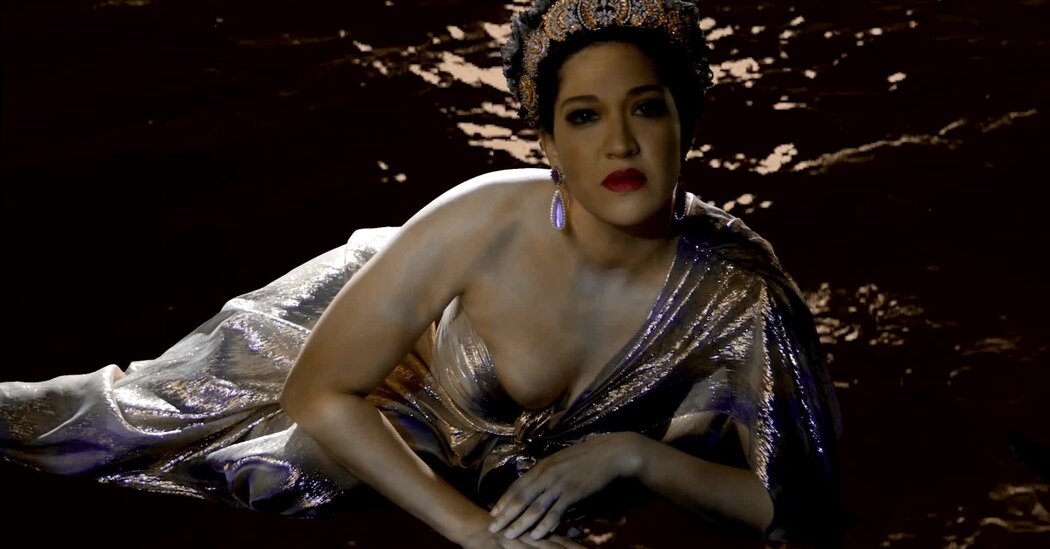On the page, John Adams’s opera “Antony and Cleopatra” is a pretty straightforward adaptation of Shakespeare’s tragedy. But on the stage, it is something else entirely.
The production of “Antony and Cleopatra” that opens at the Metropolitan Opera on Monday is by Elkhanah Pulitzer, who turns Shakespeare’s play of torn allegiances, thwarted love and ascendant authoritarianism into a study of how people’s public images are constructed. She imagines a world in which celebrities can be tantamount to gods, the way they long have been treated in Hollywood.
With all that in mind, Pulitzer developed an aesthetic universe for her production, with the help of the scenic designer Mimi Lien and the costume designer Constance Hoffman, made of three principal elements: Egypt in 30 B.C., Hollywood in the 1930s and celebrity media culture.
You can see each of those references in the third scene of the opera. Cleopatra has been left behind by Antony after he returned to Rome, and she is lounging by her pool in Alexandria, described by Pulitzer as “a deco gold world with palm leaves and her in a lovely robe drinking martinis.” Then Cleopatra receives the news of Antony’s marriage to Octavia, which throws her into a rage.
Take a closer look at how this moment comes to life through the layers of Pulitzer’s staging.
Ancient Egypt
An obvious starting point for Pulitzer and her team was Egypt. For the costumes, Hoffman said she was inspired by the play’s description of Cleopatra as a kind of goddess, with elements of Isis as represented in ancient art, while drawing freely from Ancient Egyptian representations of deities and royalty.
A large architectural feature that Lien created for the “Antony and Cleopatra” set was based on the vaulted ceiling inside the Red Pyramid. Its gentle steps were translated into a steeply angled wall that at first appears to be monolithic but later divides into pieces that move throughout the opera, sometimes coming back together and breaking apart again.
“These two pillars are huge, almost like the child’s version of Egypt and Rome,” Lien said. “In some sense they’re two sides of the coin, polar opposites in a way, and I wanted them to convey the gravitas of these two civilizations and the weight that they carry throughout history and in our consciousness.”
Thinking about Egypt also led the designers to 20th-century Egyptomania, which followed the discovery of Tutankhamen’s tomb and wormed its way into pop culture and 1930s Hollywood.
Perhaps the most famous, or at least the most lavish, movie depiction of Cleopatra was by Elizabeth Taylor in the 1960s. As an actress who was uncomfortably familiar with how she was seen by the public, Taylor was certainly an inspiration for Pulitzer’s staging. But another film version also informed the team: Cecil B. DeMille’s 1934 “Cleopatra,” starring Claudette Colbert.
That movie’s Cleopatra, whose slinky glamour wouldn’t be out of place among off-duty Hollywood actors at the time, reminded Hoffman of an Art Deco-meets-Egypt house that the art director Cedric Gibbons had built for himself and his wife Dolores del Río. Gary Cooper was draped in a zebra hide for a pool party there, a look that informed Hoffman’s designs.
“Gary Cooper was kind of posing as Hercules, playing around,” she said. “But that’s very much what Antony’s doing while he lives in Egypt, right?” (Included in Antony’s costuming for his Egypt scenes is a piece based on a tunic found in Tutankhamen’s tomb.)
A bit of Lien’s set design draws on the mesmerizingly kaleidoscopic movie musicals of Busby Berkeley, like “Dames,” released in 1934, the same year as DeMille’s “Cleopatra.” There are even dancers in the opera who surround Cleopatra, in choreography by Annie-B Parson.
Cleopatra must appear like a celebrity: effortlessly seductive but also a bit jaded while surrounded by Hollywood comforts. “She may look like a goddess,” Hoffman said, “yet she’s just a woman with a hangover.”
A celebrity wouldn’t be a celebrity without a carefully crafted public image, an idea that is hinted at through props like a spotlight that shines on Cleopatra as she lounges by the pool. She isn’t the only character to get this treatment, which also appears in propagandistic videos, hordes of paparazzi and publicity stunts throughout the opera. The performance is even framed like a Hollywood premiere, with the Met’s golden curtain, which is barely used in modern productions, down at the start to make the theater look like an old movie palace.
Cleopatra’s scene by the pool, Pulitzer said, is a “a kind of ‘Lifestyles of the Rich and Famous’ moment.” But it’s also a way for this celebrity figure to control how she is seen, combining the style and independence of someone like Josephine Baker for a feminist statement.
“Female actresses in the 1930s didn’t have a lot of agency because of the Hollywood system,” Pulitzer said, adding of Cleopatra: “So it was important that she be in control of the lens and not just some object being gazed at.”
The other major inspiration for this staging’s Cleopatra, though, is much more of our time: Beyoncé, a pop star with extraordinary control of her public image, whether on a red carpet or making her first appearance since announcing a pregnancy by singing at the Grammy Awards in a costume that could only be described as radiantly divine. That look found its way into Lien’s scenic design and Hoffman’s costume for a scene in which Cleopatra embodies 1930s glamour and Ancient Egypt in equal measure.
“For me, the Beyoncé reference is the one that really connects Cleopatra to our contemporary media culture,” Lien said. “It speaks to even TikTok and Instagram influencers — these very public figures and how they really control everything about how people perceive them.”











